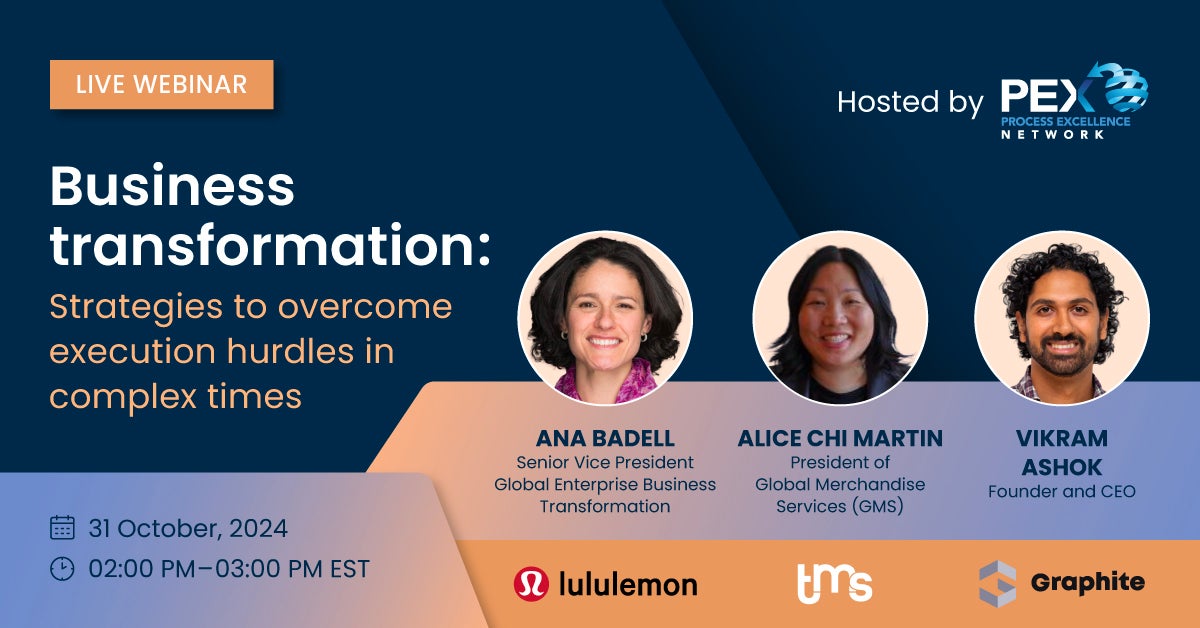Insights from the PEX Network Webinar: Diving into business transformation with Alice Chi Martin

Business transformation is a journey — one that often begins with a clear vision but evolves as new challenges and opportunities arise. At the recent PEX Network Webinar, Business Transformation: Strategies to overcome complex hurdles in complex times, tms’ President of Global Merchandising Services, Alice Chi Martin, along with leaders from Lululemon and Graphite, dove into how businesses can execute large-scale transformation initiatives effectively.
The Balancing Act of Transformation
Lululemon’s SVP of Enterprise Business Transformations, Ana Badell, set the stage by highlighting a critical point: transformation is a balance between what a company wants to do, what it needs to do, and what it can realistically do.
Alice expanded on this idea, emphasizing that while organizations often begin transformation efforts with a set plan in mind, the end result rarely aligns exactly with the original vision. The outcome of transformation efforts is often shaped not just by the “what”, but by the “how” — how the vision is executed and how the organization adjusts the process along the way. It’s not enough to have a lofty vision; teams must understand how to translate that vision into flexible, actionable strategies.
Agility in the Face of Complex Challenges
Alice also addressed the shifting landscape in which transformations occur. In recent years, businesses have faced significant market headwinds—economic pressures, budget constraints, and heightened scrutiny over spending — and must pivot efficiently to meet evolving demands. Transformation requires more than just top-down direction; it takes an ability to “flex with the needs of the company,” as the goals and challenges of an organization inevitably shift.
People-Centered Transformation
At the heart of these experts’ insights was a focus on people. Whether it’s the talent leading the transformation or the employees who will be affected by it, transformation is fundamentally a human endeavor. “You have to have the right talent and the right leaders to drive change,” Alice stated.
Alice delved into the reasons why so many transformations fail, pointing to misalignment among leaders, lack of buy-in from the outset, and conflicting priorities as primary culprits. Having the right people in the right roles is crucial, as it is these individuals who will champion change and ensure the organization stays on track. It’s essential to ask, what problem are we solving, and what talent (internal or external) do we need to get there?
The Role of Culture in Transformation
Organizational culture can either be a catalyst for change or a barrier Some organizations will need to preserve a strong existing culture while adapting to new ways of working, while others may need to completely overhaul theirsto support new strategic goals.
At the heart of transformation is the need to shift culture.
This means aligning leadership, people, and processes with the new direction while maintaining respect for the company’s heritage. To do this, you have to dive into transformation with a mindset of curiosity—listening deeply to understand where the company has been, where it is now, and where it hopes to go.
Once you’ve listened and made your plan to meet the needs of your people and your customers, it takes solid, ongoing communications to get buy-in among your team and to show success along the way to retain that engagement.
Trending


McDonald’s and tms bring a mischievous twist to the holidays with The Grinch Meal
